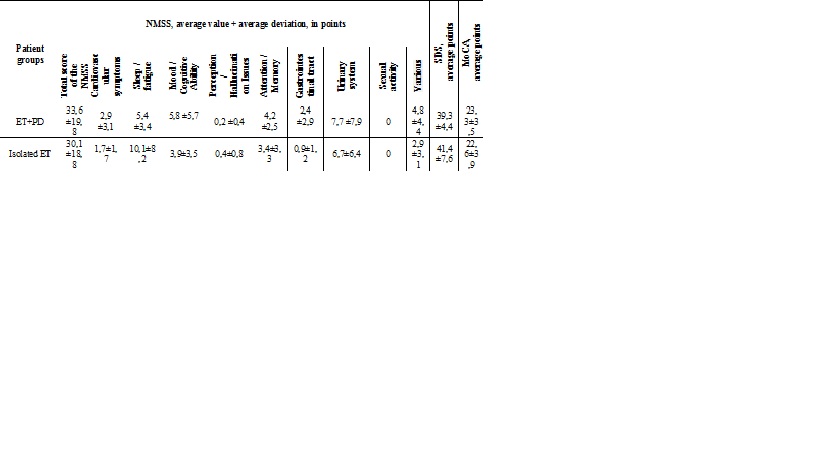Category: Parkinson's Disease: Non-Motor Symptoms
Objective: To identify non-motor symptoms – predictors of Parkinson’s disease (PD) in patients with hereditary forms of Essential tremor (ET) .
Background: ET is the most common motor disorder, the prevalence of which is more than 5% in people over 65 [1]. The prevalence of PD increases in old age, reaching 1.8% in the same age ranges [2]. Sometimes, essential tremble is combined with motor symptoms of PD. At the same time, akinetic-rigid syndrome appears in patients with ET several years to decades after the onset of tremor. These arguments are the basis for the search for PD predictors in patients with ET and biomarkers for a combination of two conditions.
Method: We examined 40 patients (average age 56±11.9, average age of onset 44.7±15.2, average duration of disease -11.3±8.3): 30 women (average age 58 ± 9.8) and 10 men (average age – 71±9.2). Of these, 21 patients with isolated ET (6 men and 15 women, average age -58.9 ± 11.2, average age of onset – 49.1±13.9, average duration of disease – 12.5±10.1) and 19 – with ET+PD (of which 4 men and 15 women, the average age was 63.9±9.2, the average age of onset was 55.7±12.7, the average duration of disease was 10.0±6, 2). The study design included a clinical – anamnestic method using the Non-Motor Symptoms Scale for Parkinson’s Disease (NMSS), the Montreal Cognitive Assessment (MoCA), the Zung’s Self-Rating Depression Scale (SDS); statistical methods.
Results: A significant difference in the age of onset, the duration of disease, the average age of patients with isolated ET and ET+PD was not detected. All patients in the ET+PD group showed non-motor symptoms; in patients with ET, 18 out of 21 showed non-motor symptoms (only in 85.7%) (Table 1). According to the data obtained from the MoCA and SDS questionnairies, there was no significant difference in cognitive-affective disorders.
Conclusion: ET+PD is 3.8 times more common in women than in men. Non-motor manifestations are detected in all patients according to the NMSS scale, only in patients with ET in combination with PD, the symptoms of dissomnia in the NMSS subscale are more pronounced. A significant difference in the indicators of the age of patients, the duration of the disease and the age of onset was not revealed. There was no significant difference in cognitive-affective disorders.
References: 1. G. Deuschl, I. Petersen, D. Lorenz, K. Christensen, Tremor in the elderly: Essential and aging-related tremor, Mov Disord 30(10) (2015) 1327-1334 2. M.C. de Rijk, M.M.B. Breteler, G.A. Graveland, A. Ott, D.E. Grobbee, F.G.A. van der Meche, A. Hofman, Prevalence of Parkinson’s disease in the elderly: The Rotterdam Study, Neurology 45(12) (1995) 2143-2146
To cite this abstract in AMA style:
Z. Zalyalova, S. Munasipova. Non-motor symptoms-predictors of Parkinson’s disease in patients with a hereditary form of essential tremor [abstract]. Mov Disord. 2020; 35 (suppl 1). https://www.mdsabstracts.org/abstract/non-motor-symptoms-predictors-of-parkinsons-disease-in-patients-with-a-hereditary-form-of-essential-tremor/. Accessed December 31, 2025.« Back to MDS Virtual Congress 2020
MDS Abstracts - https://www.mdsabstracts.org/abstract/non-motor-symptoms-predictors-of-parkinsons-disease-in-patients-with-a-hereditary-form-of-essential-tremor/

